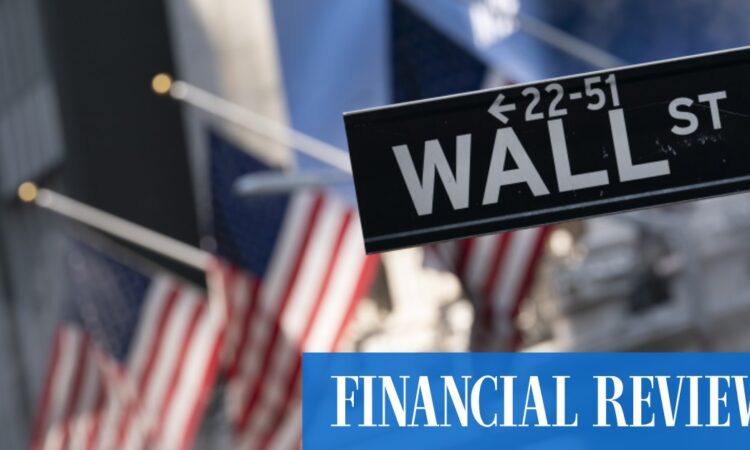
On bitstamp.net, bitcoin was 3.4 per cent higher to $US17,294 at 7am AEDT.
The yield on the US 10-year note was 4 basis points lower to 3.51 per cent near 3pm in New York.
On Wall Street, the Dow turned negative in afternoon trade and both the S&P 500 and Nasdaq pared earlier gains on renewed rate concerns. The NYSE Fang + Index was up 3.7 per cent; it was more than 4 per cent higher earlier.
“We are just going to have to hold our resolve,” Raphael Bostic, president of the Atlanta Fed, told the Atlanta Rotary Club, according to Bloomberg. He said the Fed was committed to tackling high inflation and this warrants raising interest rates into a 5 per cent to 5.25 per cent range to squeeze excess demand out of the economy.
San Francisco Fed president Mary Daly, speaking in a live-streamed interview with the Wall Street Journal, also said she expects the central bank to raise interest rates to somewhere above 5 per cent, though the ultimate level is unclear and will depend on incoming data on inflation.
Neither Bostic nor Daly has a vote on policy this year.
Today’s agenda
No local data
Overseas data: China December industrial production and retail sales; US November consumer credit
Other top stories
Panel clears route for carbon price Australia is on the cusp of entrenching a price on carbon as the Albanese government prepares to impose a mandatory cap on big industrial emitters.
Risk of even more rate rises as bank funding costs bite Mortgage rates could rise by even more than official increases this year, as funding costs soar and banks repay $188 billion of emergency money.
As pandemic measures expire, banks face more expensive funding The big banks are hitting the funding markets in size in 2023. That probably means higher deposit rates and a tougher time for their competitors.
Productivity Commission takes on Labor over waterfront The Productivity Commission has questioned whether the Albanese government new workplace laws will do enough to counter the excessive bargaining power of the Maritime Union.
Chanticleer: Stock Swami leaves a dirty stain on citizen journalism Tolga Kumova’s comprehensive defamation victory against Alan Davison, also known as Stock Swami, in the Federal Court, puts citizen journalists on notice.
Market highlights
ASX futures up 8 points or 0.11 per cent higher to 7108 near 7am AEDT
- AUD +0.7% to 69.24 US cents
- Bitcoin on bitstamp.net +3.4% to $US17,294 at 7am AEDT
- On Wall St at 3pm: Dow -0.2% S&P 500 +0.2% Nasdaq +1%
- In New York: BHP -0.02% Rio +0.8% Atlassian +4.1%
- Tesla +7.5% Apple +1.2% Amazon +2.4% Lululemon -9.4%
- In Europe: Stoxx 50 +1.5% FTSE +0.3% CAC +0.9% DAX +1.4%
- Spot gold +0.3% to $US1871.22 an ounce at 1.43pm New York time
- Brent crude +1.5% to $US79.76 a barrel
- Iron ore % to $US a tonne
- 10-year yield: US 3.51% Australia 3.72% Germany 2.22%
- US prices as of 3.01pm in New York
United States
Morgan Stanley’s Mike Wilson sees downside risks for the S&P 500. “With both sell and buy side consensus so aligned—i.e., weak first half, better second half—everyone is starting to wonder how this view could be wrong. We think it’s in the magnitude of the move lower led by much weaker earnings and a Fed committed to fighting inflation, making 3900 an easy sale.”
The S&P 500 could tumble to 3000 points if a recession arrives in the US, he said.
“Back in August, we first warned that peaking inflation is a positive for bonds, but it’s also very negative for profitability. Since then, margins have disappointed across many sectors, and we expect more of this theme in 4Q results and throughout 2023.”
“We look for price dispersion to rise over the next about 6 weeks as it has done throughout prior earnings seasons. In our view, a key driver of this pick up in dispersion will be the widening relative performance gap between those companies that are operationally efficient in this challenging macro environment and those that are not.”
Commodities
US oil futures surged as much as 4 per cent to above $US76 a barrel before paring gains. China issued a fresh batch of crude oil import quotas, a signal that the world’s largest purchaser is gearing up to meet higher demand.
This week marks the beginning of the annual rebalancing of the largest commodity indexes, a period usually characterised by volatile flows across raw materials markets.
The period should see more than $US1 billion of inflows into the global Brent benchmark, while leading to outflows from US oil, according to separate estimates from Citigroup and Societe Generale.



